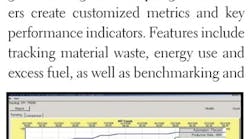Taking on more jobs all the time seems to be the direction control software is going. There seem to be few control function now that software won’t take on.
George Buckbee, director of product development at Expertune (www.expertune.com) sees that “one of the major trends in control software is that more engineering knowledge is being incorporated into real-time software, such as performance supervision systems. Software indentifies control problems, diagnoses hardware issues, prioritizes and suggests corrective actions to engineering and maintenance. These software systems operate 24/7, so they can be more vigilant than a human. The result is that companies are leveraging their limited pool of engineers more effectively. Software does the pre-work, and engineers focus on the most value-added portion of their work.”
Visualization supported by 64-bit computing is also going into more engineering toolboxes. Tim Donaldson, ICONICS director of marketing (www.iconics.com), says, “Windows Presentation Foundation (WPF) and XAML are at the core of 64-bit computing. GENESIS64 software exploits both the 2D and extensive 3D capability of WPF to deliver real-time data in a variety of visualization options. Sixty-four-bit computing enables state-of-the-art graphic hardware acceleration through DirectX10, powered by Windows Vista. Applications, integrated with the Windows Presentation Foundation and XAML, provide users with a 3D view of their operations in real-time with live data. Imagine the ability to view how equipment is running in real-time from any angle. It’s a whole new approach to visualization.”
Two of the trends in control software that Todd Stauffer, PCS 7 marketing manager, Siemens Energy & Automation (www.sea.siemens.com) sees are streamlining the engineering process to reduce costs and time, and object-oriented design that eliminates the boundaries of controller and HMI software. He says, “Engineering costs are the major component of up-front expenses associated with a new distributed control system (DCS). These expenses exceed investments in hardware, software and installation. End users, integrators and supplier engineering teams are now driven to reduce engineering costs to help them stay competitive and to ensure that new capital projects get approved. To support this trend, DCS suppliers are enhancing the engineering toolsets. New capabilities for concurrent engineering, simulation, bulk engineering and linking to P&ID design tools are being built directly into software to help teams work more efficiently.”
Stauffer goes on to say, “gone are the days when one can tell where the configuration of the controller stops and the configuration of the HMI begins. In the past, controller and HMI configuration tasks were performed separately in parallel, often by different people, with the slim chance that they would come together smoothly in the end.”
Patti Pool
[email protected]
- THREE-TIER HISTORIAN ARCHITECTURE
- PREDICTIVE MAINTENANCE TOOLS
- MOTION CONTROL AND LOW-END CONTROL
- SOUND THE ALARM
- REAL-TME ADVICE
Panel PC? Oh My! Look at this Monster!
Advantech Corporation’s IPPC-7157A is a full-featured PC industrially hardened and designed for installation in a panel on a standard 19" rack.
“This is what you can do with an industrially hardened PC,” said Rustom Lee, Advantech’s HMI Division sales and marketing director. “We didn’t compromise just because it is in a 19" rack configuration.”
The front panel is rated NEMA4/IP65, with an operating temperature from 0 ºC to 50 ºC (32 °F to 122 °F) and is designed in accordance with the EEMUA guidelines for color schemes in pleasing shades of gray.
“Fully featured” means a Pentium D 3.2 GHz dual-core CPU (others optional), up to 4 GB of DDR2 memory, and a 15" XGA TFT LCD display, with a maximum resolution of 1024 x 768 and 262k colors. It has a backlight life of 50,000 hours and a contrast ratio of 450:1. Powering this beast is a 300-watt power supply, rated 90-264 VAC at 47 Hz-63 Hz full range, with an MTBF of 100,000 hours. A 49-CFM fan, rated with an MTBF of 50,000 hours, cools the system.
The IPPC-7157A comes with 7 PCI/PCIe expansion slots, an enhanced parallel port BIOS-configurable to LPT1, 2, 3 or “disabled.” It has two serial ports, an RS-232 on the rear I/O, and an RS-232/422/485 (Modbus-capable) on the pin header. It also has a mic-in and a line-out audio port, a dual PS/2 mouse and keyboard interface, a dual 10/100/1000 Base-T LAN connection and five USB2.0 ports. A full-sized drive bay supports one FDD, two 3.5" HDD and a CD-ROM drive.
The front-panel membrane keypad has 43 operating keys and one with 10 programmable macro function keys.
The optional touchscreen interface is a USB, with a lifespan of 10 million touches.
The IPPC family supports most MS Windows operating systems, including Windows 2000, XP, Vista and Windows CE, and there’s even support for Linux, giving automation professionals wide latitude in what applications they can run directly on the Panel PC, while the 10/100Base-T and Gigabit Ethernet LAN connections permit the highest levels of connectivity to the enterprise.
The IPPC-7157A is part of a three-unit family. The 6152A has all the same features of its bigger brother, without the front-panel keypads and only two PCI slots. The 6172A version has a giant, 17" LCD with an 800:1 contrast ratio and an optional touchscreen interface instead of front panel keys.




